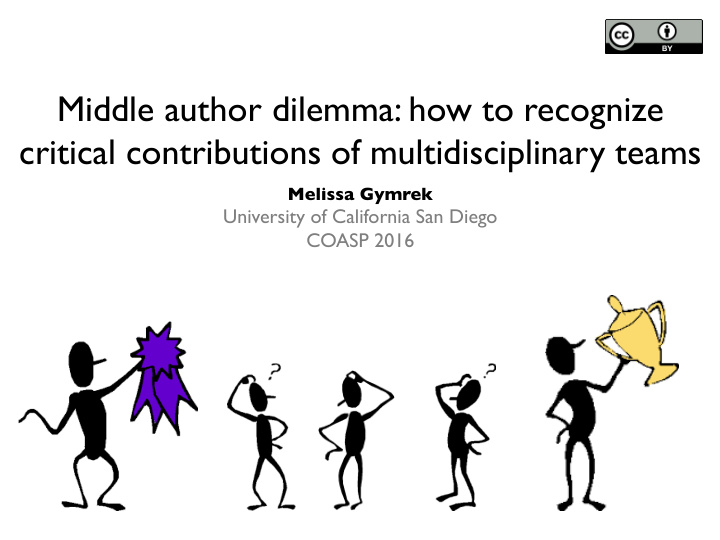



Middle author dilemma: how to recognize critical contributions of multidisciplinary teams Melissa Gymrek University of California San Diego COASP 2016
Outline • Why is authorship order so important? • The sandwich model of authorship • It get’s complicated: case studies • Potential improvements
Authorship is the currency of academia • Job applications • Grants • Promotions • Recognition
Overheard on the job market “ If you don’t have three first-author Nature, Science, or Cell ” papers, they’ll just throw your application in the trash Anonymous on applying for an assistant professorship at their institution “ We do consider co-first author papers, but only count ” them as half when counting publications. Anonymous on how their search committee ranks candidates ” “ Middle author papers don’t really count much. Anonymous on how their search committee ranks candidates
The sandwich approach to authorship Did ¡most ¡of ¡the ¡work ¡ Led ¡the ¡project ¡ * ¡ First author, ………, Middle authors, ......, Collaborator, Senior author (e.g. ¡Post-‑doc) ¡ (e.g. ¡Staff, ¡graduate ¡student) ¡ (Principal ¡Inves:gators) ¡ *Corresponding ¡author ¡ First author + , Co-first author + + These authors contributed equally Co-senior author 1 , Senior author 1 1 These authors supervised this work equally Author 2, Author 3, Author 4, …….. Author 100 Lab ¡technician, ¡doctor, ¡soFware ¡engineer, ¡sta:s:cian, ¡applied ¡mathema:cian ¡
An objective approach to author order? Example: Stephen Kosslyn’s “points” system • The idea (250 points) • The design (100 points) • The implementation (100 points) • Conducting the experiment (100 points) • Data analysis (200 points) • Writing (250 points) Minimum 10% required for authorship Order determined by points But it’s not always that easy… hGp://kosslynlab.fas.harvard.edu/files/kosslynlab/files/authorship_criteria_nov02.pdf ¡
Papers can have tens or hundreds of authors A single paper may involve: • Experimental biologist • Medical doctors • Statistician • Applied mathematician • Software engineer • Data scientist • And more… Authorship policies should encourage this kind of collaboration! But they often don’t…
Case Study1: Co-authorship Co-first author 1*, Co-first author 2*, ……… *These authors contributed equally to this work Co-first author 1: Post-doc, designed and performed experiments Co-first author 2: PhD student, led data analysis Pros : ¡ • Accommodates ¡mul:disciplinary ¡studies ¡ • Technically ¡gives ¡equal ¡credit ¡to ¡both ¡authors ¡ ¡ Cons: ¡ • Usually ¡cited ¡as ¡“FirstAuthor ¡ et ¡al.” ¡ • In ¡print ¡one ¡name ¡must ¡be ¡listed ¡first ¡
Case Study1I: Consortia 1000 Genomes Project – author list Pros : ¡ • Allow ¡for ¡huge ¡mul:-‑ins:tu:on ¡collabora:ons ¡ Cons: ¡ • Hard ¡to ¡discern ¡contribu:ons ¡of ¡any ¡one ¡author ¡
Case Study III: “Gift authorship” First author, ……, Co-senior author 2*, Co-senior author 1* *To whom correspondence should be addressed Co-senior author 1: Led and funded the study Co-senior author 2: First author’s advisor, not involved in this study Cons: ¡ • Dishonest ¡portrayal ¡of ¡who ¡was ¡involved ¡ • Gives ¡a ¡false ¡impression ¡of ¡whose ¡lab ¡led ¡the ¡project ¡
Idea 1: Explicitly describe author contributions Example: ¡
Idea 2: Smaller citable units Example : Supplemental “chapters”
Idea 3: Cite things that aren’t publications • Cite source code • JOSS (The Journal of Open Source Software) http://joss.theoj.org/ - a developer friendly journal for research software packages • Zenodo http://zenodo.org/ - get a DOI for a github repo • Cite data, presentations, posters, etc. • DataCite – assigns DOIs to datasets • Figshare – share research outputs, e.g. data, figures, videos. DOI from DataCite
Summary • Authorship order is a tricky issue, especially in large, multidisciplinary studies • Authorship is the primary criterion by which scientists are evaluated • Authorship policies should promote collaboration and reward diverse types of contributions • Existing solutions aren’t perfect
Acknowledgements Broad Institute Sci Pub Working Group Journal of Open Source Science Alon Goren Yossi Farjoun Shai Fuchs
Recommend
More recommend